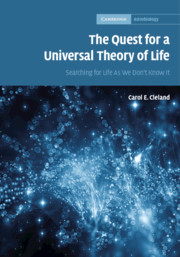Book contents
- The Quest for a Universal Theory of Life
- Reviews
- Cambridge Astrobiology
- The Quest for a Universal Theory of Life
- Copyright page
- Dedication
- Contents
- Acknowledgments
- Introduction
- 1 The Enduring Legacy of Aristotle: The Battle over Life as Self-Organization or (Genetic-Based) Reproduction
- 2 Why Life Cannot Be Defined
- 3 What Is a Scientific Theory?
- 4 How Scientific Theories Develop
- 5 Challenges for a Universal Theory of Life
- 6 Rethinking the Traditional Paradigm for Life: Lessons from the World of Microbes
- 7 Artificial Life: Could ALife Solve the N = 1N=1 Problem?
- 8 Searching for Extraterrestrial Life Without a Definition or Universal Theory of Life
- 9 A Shadow Biosphere: Alien Microbes on Earth?
- Conclusion
- References
- Index
7 - Artificial Life: Could ALife Solve the N = 1N=1 Problem?
Published online by Cambridge University Press: 05 September 2019
- The Quest for a Universal Theory of Life
- Reviews
- Cambridge Astrobiology
- The Quest for a Universal Theory of Life
- Copyright page
- Dedication
- Contents
- Acknowledgments
- Introduction
- 1 The Enduring Legacy of Aristotle: The Battle over Life as Self-Organization or (Genetic-Based) Reproduction
- 2 Why Life Cannot Be Defined
- 3 What Is a Scientific Theory?
- 4 How Scientific Theories Develop
- 5 Challenges for a Universal Theory of Life
- 6 Rethinking the Traditional Paradigm for Life: Lessons from the World of Microbes
- 7 Artificial Life: Could ALife Solve the N = 1N=1 Problem?
- 8 Searching for Extraterrestrial Life Without a Definition or Universal Theory of Life
- 9 A Shadow Biosphere: Alien Microbes on Earth?
- Conclusion
- References
- Index
Summary
Some artificial life (ALife) researchers contend that we are on the verge of creating novel life forms either in the form of information structures in a computer (soft ALife), robots made of plastic and metal (hard ALife), or synthetic organisms composed of unnatural biomolecules (wet ALife or synthetic biology). In the words of computer scientist Chris Langton, a founder of ALife, “Artificial life can contribute to theoretical biology by locating life-as-we-know-it within the larger picture of life-as-it-could-be” (Langton 1989, 1). Similarly, in a discussion of synthetic life, Mark Bedau and colleagues note that “[o]ne of artificial life’s key goals is constructing a life form in the laboratory from scratch” (Bedau et al. 2000, 365). This chapter evaluates whether ALife research can live up to its hype and deliver truly novel forms of life. As will become apparent, the inventions of ALife are very closely based on characteristics of familiar Earth life. In addition, they tend to fall outside of the Goldilocks level of abstraction (Section 4.3) in being either too abstract (soft and hard ALife) or too concrete (wet ALife).
- Type
- Chapter
- Information
- The Quest for a Universal Theory of LifeSearching for Life As We Don't Know It, pp. 161 - 171Publisher: Cambridge University PressPrint publication year: 2019



